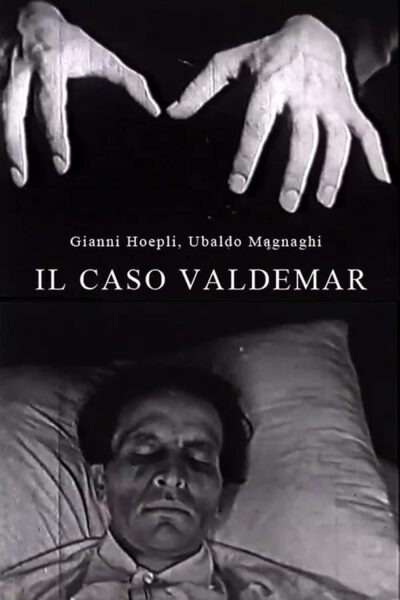 Another highly expressionistic 1930s Edgar Allan Poe inspired horror obscurity, following 1934’s BUCKET OF BLOOD. The Italian made short IL CASO VALDEMAR hails from 1936, and stands as a companion-piece of sorts to the earlier film.
Another highly expressionistic 1930s Edgar Allan Poe inspired horror obscurity, following 1934’s BUCKET OF BLOOD. The Italian made short IL CASO VALDEMAR hails from 1936, and stands as a companion-piece of sorts to the earlier film.
IL CASO VALDEMAR an adaptation of Poe’s 1845 story “The Facts in the Case of M. Valdemar,” which described the mortally ill title character being put into a hypnotic fugue at the moment of his death, and how upon being awakened Valdemar’s body immediately decays. Other screen adaptations of this tale include segments of the Argentine anthology film MASTERWORKS OF TERROR/Obras maestras del terror (1960), the Roger Corman production TALES OF TERROR (1962), the George Romero portion of TWO EVIL EYES (1990) and the animated EXTRAORDINARY TALES (2015), as well as two versions by Spain’s Narciso Ibáñez Serrador in seasons one (1966) and three (1982) of Serrandor’s self-created series HISTORIAS PARA NO DORMIR.
IL CASO VALDEMAR only lasts 12 minutes, but its directors Gianni Hoepli (whose only imdb credit this is) and Ubaldo Magnaghi (of the 1933 Milan travelogue MEDIOLANUM) keep the film lively, eye-catching and, in the final scenes, gruesome. It’s said to be Italy’s—and indeed the world’s—first gore film.
The film opens with a text informing us that hypnosis can slow the effects of death, which “eventually resume at a faster rate once the hypnotic sleep ceases.” What follows is a succession of rigorously composed, precisely lit images, depicting how at a séance the mesmerist Allan (Lav Kamenarovic) is contacted by some ghostly entity via a penciled note—which becomes this sound-free film’s mode of dispensing dialogue and narration—that implores him to hypnotize his dying friend Valdemar (Gino Eprisi) in order to prolong his life.
Allan and his colleagues head to Valdemar’s house, where he’s being looked after by a nun (Iberia Bollain) and three hysterical women. As instructed, Allan hypnotizes the dying Valdemar, in which state he remains from October 11 to April 22, 1928. It’s then that Allan finally awakens Valdemar from his trance, only to, as was forewarned by the prologue, have the man decompose before his and his companions’ shocked eyes.
The highly exaggerated shots of the onlookers screaming and covering their faces during the decomposition scene could have stood to be toned down, as could the clumsy montage editing (the one aspect that really gives away the filmmakers’ amateur status), but the expressionistic visuals are pretty impeccable otherwise. The directors favor esoteric camera angles viewed from every conceivable vantage (even, on occasion, horizontal), with textured clothing (which is given many a lingering close-up) and crucifixes (allowing the filmmakers to make a symbolic point about the clash between spirituality and the occult) being vitally important to the visual aesthetic.
A large portion of the credit must go to make-up artist Antonio Marini, who created the lovingly photographed gross-out climax. Utilized was a clay face subjected to heat lamps and time-lapse photography, a simple effect but an extremely effective one, and something that would have been off-limits in 1936 Hollywood (where the Hays Code governing motion picture content was rigidly enforced starting in 1934). Marini would go on to utilize his expertise on films like GOLIATH AND THE VAMPIRES/Maciste contro il vampire (1961) and HERCULES AGAINST THE MOON MEN/Maciste e la regina di Samar (1964), but it all started with IL CASO VALDEMAR.
Vital Statistics
IL CASO VALDEMAR
Directors: Gianni Hoepli, Ubaldo Magnaghi
Cast: Lav Kamenarovic, Gino Eprisi, Carlo Bissi, Vincenzo Gatti,
Iberia Bollain, Maria Marussig, Gina Romanelli, Ester Gelik Sainati, “N.N.” (Gianni Hoepli)
